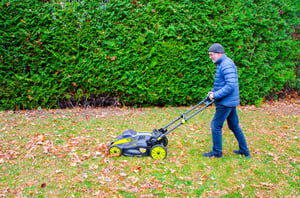 Fall has officially arrived! Now’s the best time of year to give your lawn some TLC. Unfortunately, summer heat, drought, weeds, disease, and insects can cause damage. So, before the snow starts flying, here are some simple things you can do to help your lawn recover from summer and flourish next spring.
Fall has officially arrived! Now’s the best time of year to give your lawn some TLC. Unfortunately, summer heat, drought, weeds, disease, and insects can cause damage. So, before the snow starts flying, here are some simple things you can do to help your lawn recover from summer and flourish next spring.
1. Adjust your watering schedule.
A lawn needs about one inch of water per week. During the hot summer months, it likely needed more. While cooler temperatures and increased rainfall are more common this time of year, it doesn’t mean you can stop watering. Water is still needed up until the winter freeze. When the average nighttime temperatures are consistently in the low 30s, you can stop watering.
2. Don’t skip fall fertilizing.
Fall treatments can help your grass grow stronger roots which can help minimize damage from harsh winter weather. It’s also a good way to help jumpstart your lawn when spring and warmer temperatures return.
3. Don’t cut your lawn too short.
During the summer months it’s recommended that you mow your lawn at the highest mower deck setting. Doing this leads to:
a. Less water usage
b. A greener appearance
c. Fewer weeds
d. Overall healthier grass
Resist the urge to start cutting it short now. Continue to cut it high only removing one-third of the leaf tissue. For your final cut of the season don’t immediately lower it to the lowest deck setting. Make several cuts lowering your lawn mower deck each time until you get to your desired level.
4. Pick up fallen leaves.
Trees with leaves colored in yellow, orange, and red create impressive scenery. However, after they’ve fallen it’s important to clean them up. Piles of leaves can kill or damage your grass. Leaves can block sunlight and reduce water evaporation. This results in fungus, mold, and disease.
5. Re-seed bare spots.
The best times of year to plant grass are spring and fall. Throwing down some seed now, allows it to grow during these times. This extra time helps prepare the grass for the hot summer months ahead. If for some reason it doesn’t grow, you still have another chance to give it a try in spring.
Not doing anything this fall can cause even more damage to your lawn, so do what you can. Every little bit helps for the following growing season.
Do you have any suggestions or information you’d like to share? I’d love to hear from you. Please share them in the box below.





